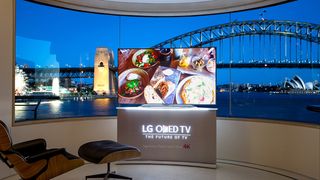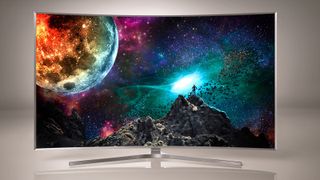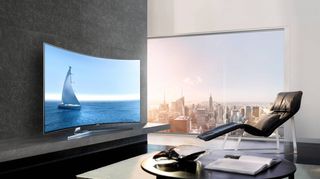
TV tech is on the move again. From the relative simplicity of 1080p versus 4K resolution, we humble buyers now have to contend with HDR (High Dynamic Range) in all its multiple flavours.
HDR has pushed screen makers to new levels of innovation. The idea of higher peak brightness and wider colour range (the two key attributes of HDR) may sound relatively straightforward, but executing them has caused a fundamental rethink with display technologies – and there's no clear consensus between brands (or I suspect even within brands) as to which solution is best.
So how do the approaches of the three biggest innovators, Samsung, LG and Sony, compare? They all have a very different idea about how best to bring home the incredible dynamics and wide colour of HDR…
Samsung SUHD Quantum Dot TVs
Quantum Dot technology is the future of TV… at least according to Samsung. We know this because it shills the point at every opportunity, but what makes QD so interesting?
In short, it's allowed Samsung to reconceptualise TV construction.

Quantum Dot nano-particles are pretty useful. They're incredibly efficient when it comes to brightness, and are capable of astonishing colour purity. 10,000 times smaller than a human hair, they can deliver perfect primary colours, depending on their particle size. But Samsung doesn't use Quantum Dots for the display itself, instead they're used as a backlight enhancement.
In a common or garden LED backlit LCD TVs, those white LED backlights are actually blue, coated with yellow phosphor. This coating leads to diminished intensity, one reason why many LCD TVs produce an orangey red. Using a Quantum Dot Enhanced Film (or QDEF) layer between the TV backlight and the Liquid Crystal panel can fix this.
Get daily insight, inspiration and deals in your inbox
Get the hottest deals available in your inbox plus news, reviews, opinion, analysis and more from the TechRadar team.
The phosphor can be removed and the native blue backlight, mixed with Red and Green produced by the QDEF filter, produces a brilliant white light, which allows the attached LCD panel module to function more efficiently. The result is more accurate colour – and lots of it. The range-topping UE55KS9000, for example, claims to cover 96 per cent of the DCI P3 colour spectrum. This, and the ability to deliver a better peak luminance, make QD screens seem a natural for HDR content.
Spend five minutes spent with any Samsung TV boffin and they'll also tell you quite emphatically that inorganic Quantum Dots are not prone to aged related degradation. A Quantum Dot screen bought today, should be just as bright a decade hence. That's not something OLED vendors are prepared to claim.

But adopting Quantum Dots alone does resolve fundamental LCD issues of limited contrast and haloing around bright objects on a dark background. This remains a problem that both edge-lit screens and local dimming full array models struggle with.
Samsung hopes to solve this with QLED, a next generation screen technology which looks likely to jettison that LED backlight in favour of an organic light source, or involve some sort of shift to directly energised electroluminescent Quantum Dots. QLED TVs (however they end up being made) could theoretically be 30 per cent brighter than OLED, but have comparable black levels. But we'll probably have to wait till 2018 or so before we get a proper first look.
LG OLED TVs
LED LCD TVs may be unable to deliver a really good black, but that's an area where OLED shines (or rather, doesn't). This is because organic LED panels are self emissive. Like plasma TVs of yore, they don't require a constantly beaming backlight. When you need total black, the pixels literally turn off.
The catch is OLED panels can't deliver the kind of peak brightness that high-end LCD screens muster either.

This discrepancy has led to two different certification grades for Ultra HD premium HDR capable TVs. Ultra HD Premium badge certification can be applied to LED displays which offer more than 1000 nits peak brightness and less than 0.05 nits black level, or OLED TVs which only offer 540 nits peak brightness yet drop to 0.0005 nits black level. A disparity that makes sense when you consider certification is a guarantee of range, not brightness.
Of course, when you're watching HDR on an OLED TV, the perceived dynamic contrast, often seems just as great as that on an LED LCD display. And some might argue it's less fatiguing to watch too.
Significantly, OLED also doesn't suffer from unwanted haloing around areas of brightness on dark backgrounds, either, as there's no backlight chicanery to disguise.
If only there was a display technology which combined the black level performance of OLED with the brightness of top end LED LCDs…
Sony Backlight Master Drive TVs (a.k.a. the Z-Series)
Making its debut on Sony's Z-Series flagship 4K screens this autumn, the Backlight Master Drive is a new backlighting technique which seeks to combine the black level performance of OLED with the extreme peak luminance associated with HDR.
First seen in prototype form at CES 2016, this ingenious direct array technology sets out to address many of the problems associated with conventional backlighting.
While Sony is keeping specifics under wraps, we do know the system uses an undisclosed number of precision controllable white LEDs driven by a highly accurate lighting algorithm.

These LEDs use a calibrated beam design which focuses the LED light into a defined spot. The effect is less diffusion. The splashy, often indiscriminate halo often seen around bright objects is largely eradicated.
Peak highlights are crisply delineated against dark backgrounds. The visual effect is far more OLED like than you might image. Yet peak luminosity, a benefit of LCD backlighting, remains high. Allied to Sony's own X-Tended Dynamic Range Pro image processing, HDR highlights really zing. Backlight Master Drive technology really does appear to offer the best of both worlds.
So who has the better TV tech?
Inevitably, all these competing TV designs have strength and weakness but in all cases the pros significantly outweigh the cons.
Samsung's SUHD implementation of Quantum Dot combines extreme HDR brightness with a rich, wide colour gamut; LG OLED delivers unbeatable black level performance with dynamic colour performance; and Sony's Backlight Master Drive combines OLED-like contrast with huge luminosity.
When it comes to image performance, it seems TV buyers have never had so many great (or difficult) choices to make.
- Still can't decide? Check out our guide to the best 4K TVs in 2016
Steve has been writing about AV and home cinema since the dawn of time, or more accurately, since the glory days of VHS and Betamax. He has strong opinions on the latest TV technology, Hi-Fi and Blu-ray/media players, and likes nothing better than to crank up his ludicrously powerful home theatre system to binge-watch TV shows.
Most Popular



